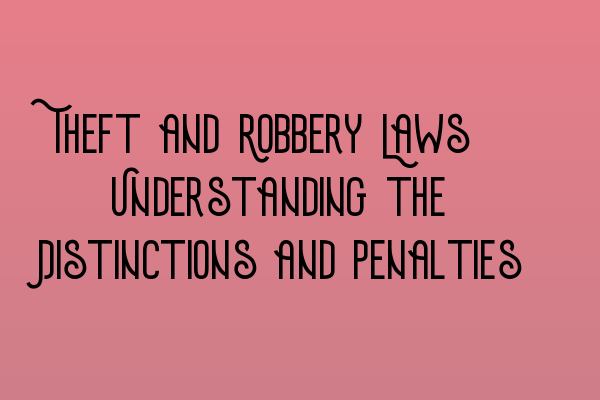Theft and Robbery Laws: Understanding the Distinctions and Penalties
Introduction
When it comes to crimes involving property, two often misunderstood terms are theft and robbery. While both involve the unlawful taking of someone else’s belongings, they differ in key aspects, including the level of force used and the penalties imposed. In this article, we will delve into the distinctions between theft and robbery, as well as the corresponding penalties.
Theft
Theft, as defined by the law, refers to the act of dishonestly appropriating property belonging to another person with the intention to permanently deprive them of it. It involves taking someone else’s property without their consent, without using force or the threat of force. Examples of theft can range from shoplifting to embezzlement.
Under SQE criminal law, theft is considered a statutory offense and carries penalties commensurate with the value of the stolen property. For more information on theft offenses and penalties, check out our related article on SQE 1 Practice Exam Questions.
Robbery
On the other hand, robbery involves using force, or the threat of force, to unlawfully take someone else’s property. Unlike theft, which can occur without the victim’s knowledge or presence, robbery invariably involves a direct confrontation between the perpetrator and the victim. The intent to permanently deprive the victim of their property is also necessary for a crime to be considered robbery.
Robbery is a much more serious offense than theft due to the element of violence or intimidation. The penalties for robbery are typically more severe and can vary depending on the nature and circumstances of the crime. To learn more about robbery offenses and their corresponding penalties, take a look at our article on SQE 1 Practice Mocks FLK1 FLK2.
Differences Between Theft and Robbery
While both theft and robbery involve unlawfully taking someone else’s property, there are key distinctions to be aware of:
- Use of Force or Threat: Theft does not involve the use of force or the threat of force, whereas robbery does. The presence of force or threat is what differentiates the two crimes.
- Direct Confrontation: Theft can occur without the victim’s knowledge or presence, while robbery requires a direct confrontation between the perpetrator and the victim.
- Intent: Both theft and robbery require the intent to permanently deprive the victim of their property. This means that the perpetrator has no intention of returning the stolen items.
Punishments
As mentioned earlier, the penalties for theft and robbery differ due to the varying nature and severity of the crimes. Theft offenses are categorized based on the value of the stolen property, with punishments ranging from fines to imprisonment. In contrast, robbery offenses can lead to lengthy prison sentences, especially if firearms or other dangerous weapons are involved.
If you are seeking more information on the penalties associated with theft and robbery, our related articles on SQE 2 Preparation Courses and SQE 1 Preparation Courses delve deeper into the topic.
Conclusion
Understanding the distinctions between theft and robbery is crucial for both legal professionals and individuals seeking to navigate the criminal justice system. While theft involves the unlawful taking of someone else’s property without the use of force, robbery adds an element of violence or threat to the equation. By knowing the differences and corresponding penalties, we can better protect ourselves and advocate for justice.
For more information on SQE exams and important dates, visit our article on SRA SQE Exam Dates.
